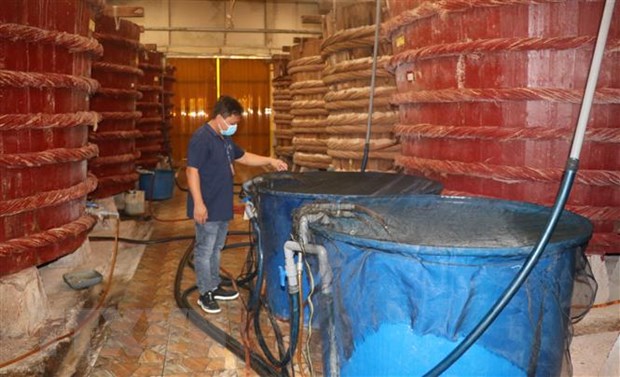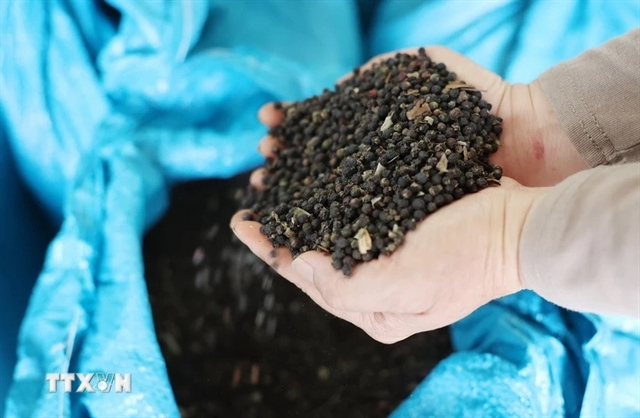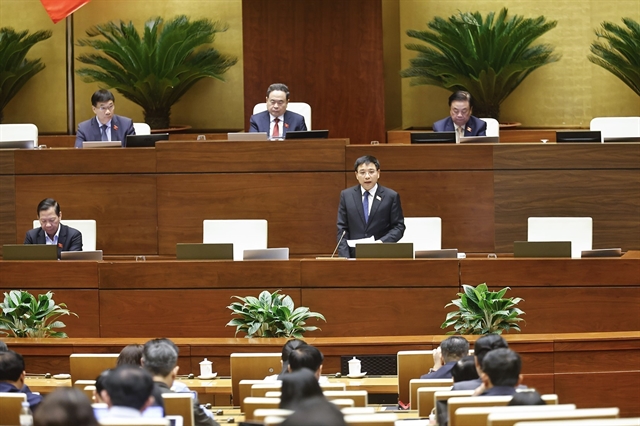 Economy
Economy


|
| A fish sauce production establishment on Phú Quốc Island. VNA/VNS Photo |
KIÊN GIANG — The fish sauce-making industry on Phú Quốc Island has existed for more than 200 years and has become the main traditional craft of the island in the Mekong Delta province of Kiên Giang.
However, the craft faces many difficulties and challenges and needs synchronous solutions for sustainable development.
Phú Quốc is home to about 60 fish sauce production establishments, mainly concentrated in Dương Đông and An Thới wards, with estimated output reaching over 18-20 million litres per year.
The number of production establishments has reduced by about 40 per cent compared to the 2011-2012 period, Tin Tức (News) newspaper reported.
Fish sauce is mainly sold to businesses in Rạch Giá, HCM cities and Cần Thơ Province for bottling and consumption.
Only 20 fish sauce makers on the island bottle their products and have their brands.
Seven local businesses are eligible to export fish sauce to Europe, South Korea, China, and Japan, and the remaining meets food safety standards for domestic consumption or exporting through distributors.
Chairwoman of the Phú Quốc Fish Sauce Association, Hồ Kim Liên said Phú Quốc fish sauce was granted protection of geographical indication (GI) in 2021 and was the first product in Việt Nam to secure such status.
However, the management of the local fish sauce products with geographical indications has still shown shortcomings.
It includes the overlap in product labels between the products with a non-geographical indication of enterprises inside and outside the province.
The legal corridor is unclear, and the products with GI recognition have not been protected strictly, Liên said.
Phú Quốc fish sauce faces fierce competition from traditional fish sauces in other regions with lower prices and different industrial fish sauces.
Some consumers cannot identify genuine Phú Quốc traditional fish sauce, leading to unstable prices and low consumption.
The promotion and introduction of products have not been paid attention to.
Another difficulty for the industry is that the raw anchovy for fish sauce production has decreased significantly due to overexploitation.
Over the past ten years, many fish sauce manufacturers on the island have had to dissolve due to a lack of raw materials for production, according to the provincial Department of Agriculture and Rural Development.
During the 2011-2012 period, the output of fish sauce reached 25-30 million litres a year, equivalent to about 40,000 tonnes of raw anchovy. Currently, the average annual output of anchovy is 20,000-22,000 tonnes, meeting nearly 50-60 per cent of the demand for production.
Some big fish sauce makers have reduced their production or suspended operations and invested in building ships to catch anchovies. But these are only temporary solutions, Liên said.
The high cost and scarce source of wood materials to make barrels for fish sauce production have also affected this industry.
Moreover, high urbanisation and robust development of tourism projects on the island have changed the labour force in traditional craft and affected the investment for developing fish sauce production.
Vice chairman of Phú Quốc City People's Committee Phạm Văn Nghiệp said Phú Quốc fish sauce, which has been recognised as the national intangible cultural heritage, has colour and traditional flavour that cannot be found anywhere else.
It has become a typical and attractive local tourism product of the island, significantly contributing to the regional socio-economic development strategy.
To develop the sustainably and effectively the craft, Liên said Phú Quốc City urgently needs to invest in developing this industry and promoting its products associated with community tourism; to build a fish sauce museum and organise an annual Phú Quốc fish sauce festival.
It is necessary to have a legal corridor to protect the island's traditional fish sauce.
Kiên Giang Province is suggested to implement solutions to protect anchovy resources, ensuring raw materials for fish sauce production.
Building a responsible, sustainable, efficient anchovy fishing community and a stable raw material area is also needed, Liên said.
The province needs to implement regulations on fishing strictly, especially not fishing in the spawning season; strictly prohibit destructive fishing practices; zone and protect the areas of anchovies.
Types of means, regulations on the light intensity, fishing areas and seasons also need to be strictly managed to ensure the sustainable development of anchovy resources on the fishing grounds.
The province needs to develop local technical regulations for Phú Quốc fish sauce to ensure stability and uniformity in quality, protecting the island's traditional fish sauce product and avoiding the encroachment of cheap industrial fish sauce products.
Liên said policies and mechanisms must also be perfected to encourage businesses to preserve and promote the Phú Quốc fish sauce brand and support them to participate in fairs, exhibitions, and trade conferences in order to connect supply and demand, expand domestic and foreign markets as well as promote an active role of the Phú Quốc Fish Sauce Association. VNS




